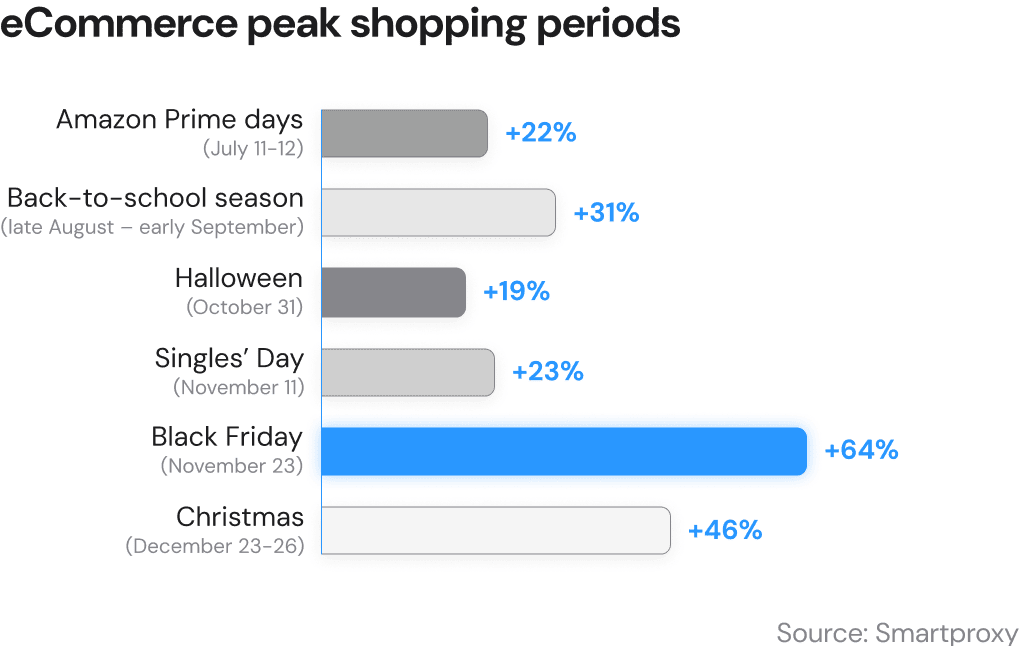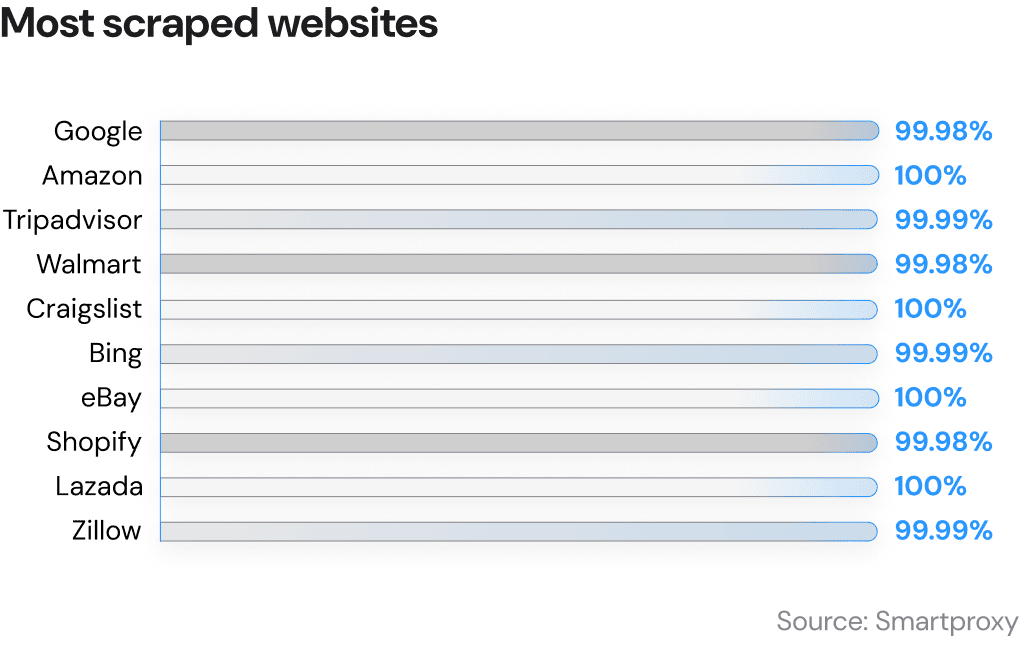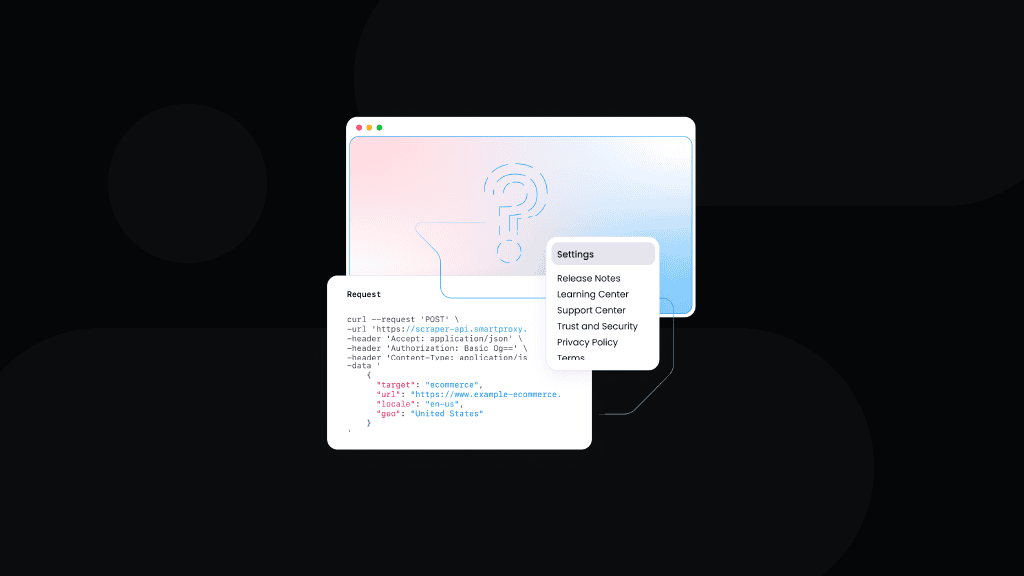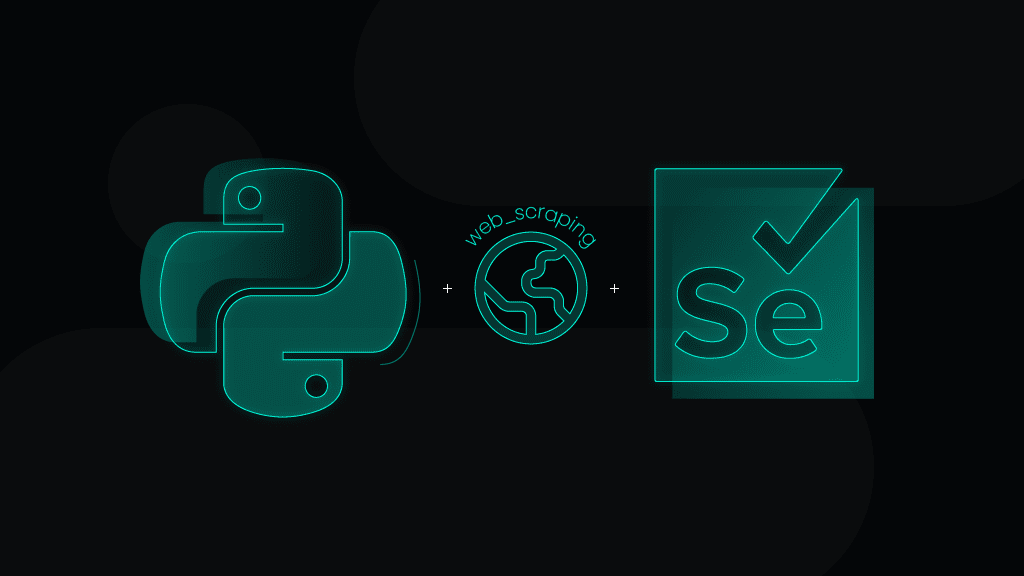Behind the Clicks: Most Scraped Websites of 2024
In 2006, British mathematician Clive Humby coined the phrase "data is the new oil." He pointed out that "much like oil, data holds significant value," meaning that big data’s potential remains untapped without proper structure and refinement. Over the next 18 years, more companies started collecting large amounts of data to get a bird’s eye view of the competition, unlock new growth opportunities, and explore the ever-changing user behavior. And in the AI era, more businesses are exploring the ability to employ robots to do their time-wasting data collection tasks. Instagram and massive sales from it.
Intro to most scraped targets report
However, one question remains: if the number of companies that leverage real-time data grows, what are the most scraped targets in 2024, and how can you utilize the data collected from those targets to power up the growth of your project?
In this article, we uncover the most scraped targets of 2023 and 2024 Q1 and share the experts’ tips on collecting real-time data more efficiently with various solutions the market offers.

Categories of most scraped websites
From just a few requests throughout the year to millions in a single day, there’s a noticeable trend in which website categories were the most popular among our users. Here are the categories of the most scraped websites.
Search engines
In 2023 and 2024 Q1, search engines made up over 42% of all Scraping APIs requests. Usually, marketing gurus collect large amounts of data for SEO analysis, keyword research, content optimization, and market trend tracking. Real-time SERP data allows marketers to enhance their online visibility, tailor content to audience preferences, and stay ahead of competitors.
Real-time data from SERPs is also helpful for advertisers, as they can refine their targeting strategies, find new keywords to bid on and maximize their ROI in low-competition search queries.
Social media
Due to their wealth of publicly available data, in 2023 and 2024 Q1, social media emerged as one of the most popular scraping targets, collecting over 27% of all requests. Businesses use this data for various purposes, including monitoring brand sentiment, analyzing market trends, and conducting competitor research. By scraping social media platforms, companies can gain insights into customer preferences, track the effectiveness of their paid advertising campaigns, and identify communication gaps.
Companies often seek a multi-platform scraping solution to collect real-time data from various targets, eliminating the need for a custom-built scraping API for each social media platform, efficiently saving time and budget.
eCommerce
According to our user base, over 18% of all requests were attributed to online shopping platforms. Users scrape eCommerce websites to gather product data for price comparison, market analysis, trend tracking, and competitive intelligence. Publicly available web data allows them to optimize their pricing strategies, identify top-selling products, and analyze the peak shopping hours to better their offering's positioning.
Interestingly, eCommerce data collection is becoming a thing among savvy shoppers who want to ensure they get the best market price. So, for businesses, offering the cheapest price tag is still the critical factor determining whether the online store visitor converts.
Community forums
Community managers and marketers around the globe rely on forums as one of the best social listening tools. The importance of such platforms is also visible by looking at our target list – community forums are attributed for 7% of all Scraping APIs requests.
Publicly available data from community forums allow marketers to conduct sentiment analysis, identify new trends, search for new content topics, and analyze the competitive landscape.
Additionally, advertisers leverage forum data to identify new niche audiences and uncover potential keywords for ad campaigns.
Real estate
Real estate websites made up over 3% of all Scraping APIs requests. Whether users were house-hunting, checking out property prices, or just keeping tabs on the market, the data collected from real estate platforms helped them make better-informed decisions.
Companies and advertisers were also leveraging real estate data. For companies, such information helped them monitor competitor listings, adjust their pricing strategies, analyze user reviews, and identify areas for improvement. Meanwhile, advertising gurus can target potential buyers and renters with ads that really hit the mark.
Other
Under this category fall all other targets not attributed to eCommerce, search engines, forums, or real estate platforms. However, such websites were attributed to 3% of all requests made in 2023 and 2024 Q1.

Data collection trends
Peaks during shopping festivals
During festive and sale seasons, data collection from eCommerce targets experienced a significant surge. With consumers actively hunting for discounts and special offers, platforms like Amazon, eBay, and Shopify witness a dramatic increase in traffic and transactions.
Such heightened activity converts into valuable data for businesses and analysts to explore, including trends in consumer behavior, popular product categories, and emerging market opportunities.
Based on our Scraping APIs requests, we’ve seen an increase in data collection in all eCommerce targets during these peak shopping periods:
- Amazon Prime days (July 11-12) +22%
- Back-to-school season (late August – early September) +31%
- Halloween (October 31) +19%
- Singles’ Day (November 11) +23%
- Black Friday (November 23) +64%
- Christmas (December 23-26) +46%
"During peak shopping periods, such as festive seasons and major sales events, we've seen a substantial increase in the use of our scraping solutions for data collection. This rise is particularly evident on high-traffic days like Amazon Prime Days, the back-to-school season, and Black Friday, where platforms such as Amazon, eBay, and Shopify experience significant surges in consumer activity.
Businesses intensify their scraping efforts during these times to capture the value of data generated by the rush of online shoppers seeking discounts and special offers. This data is crucial for gaining comprehensive insights into consumer behavior, identifying popular product categories, and spotting emerging market trends. By analyzing the rich datasets collected during these periods, companies can fine-tune their marketing strategies, optimize inventory levels, and tailor their offerings to better meet consumer demand.
Compared to previous years, we have seen that more eCommerce businesses have started to leverage real-time data to train their decision-making muscle. By harnessing the power of detailed, timely data, companies can stay agile, respond quickly to market shifts, and drive innovation, ultimately enhancing their competitive edge and ensuring sustained growth." – Vytautas Savickas, CEO at Smartproxy
Real-time data for AI training
Along with the most popular use cases, like keyword analysis, price monitoring, and ad verification, we have identified a new vertical in which real-time data plays a crucial role.
Training predictive models. Predictive modeling, also known as predictive analytics, involves creating AI models that recognize patterns in historical data to forecast future events and outcomes, enabling businesses to take decision-making and strategic planning to a more data-backed level. Predictive model training requires massive datasets to ensure accuracy. For example, financial analysts might scrape stock market data and news articles to predict stock price movements. Another use case is popular among real estate agencies, where they feed AI models with data from various housing platforms to predict the pricing trends of the most popular neighborhoods in the area. By continuously feeding this real-time data into their models, they can improve the accuracy and reliability of their predictions.
Web scraping solutions automate the collection of large volumes of data from various targets, which is far more efficient than data gathering using simple scraping tools and more cost-effective than building a custom in-house scraping infrastructure. It also helps to access and collect data from targets with sophisticated anti-bot systems. Additionally, web scraping can gather diverse data types, such as text, images, and structured data, enriching the dataset for more robust model training.
NLP models optimization. Natural language processing (NLP) underpins conversational AI applications but faces challenges due to the complexity of human language, which includes slang, ambiguity, or sarcasm. NLP models require extensive and varied data to interpret and respond to human speech accurately. For example, a customer support chatbot can be trained using recent user interactions and feedback scraped from review sites, improving its ability to handle inquiries and provide helpful responses.
Web scraping provides a continuous and diverse stream of textual data from articles, forums, news outlets, and other community platforms, representing multiple languages, syntaxes, and sentiments. This up-to-date data pool helps train NLP models to understand the context and nuances of human language better.
Data collection from social media platforms
Over 5.07B people worldwide now use social media, and 259M new users have joined within the last year. And with an abundance of textual and visual user-generated content on various brands, companies can run web scraping solutions to gain a competitive edge.
In 2024, companies leverage data collected from social media platforms to enhance customer engagement. One prominent use case is social media monitoring, where companies employ sentiment analysis to gauge online perception of their brands, products, and services. By analyzing the tone and context of user-generated content, businesses can identify and respond to customer feedback, manage reputational risks, and tailor their marketing strategies to resonate more effectively with their audience.
Social media marketplaces provide a rich repository of consumer behavior data, enabling businesses to track purchasing patterns, identify trending offerings, and optimize product catalogs. This data-driven approach helps predict market shifts and align inventory with the current demand.
Competitor research is another everyday use case, where companies collect publicly available data about their rivals on social media. This includes analyzing their advertising campaigns, customer engagement tactics, and overall brand presence. Businesses can capitalize on unmet customer needs by understanding competitors' strategies and market reception.
Advanced scraping solutions can help automate data collection, and AI-powered tools will take care of the real-time data analysis, presenting insights on the industry, brand, or even keyword level.
Most scraped websites of 2024
We've identified and listed the most popular web scraping targets based on the data collected from our Scraping APIs user base.
"As we navigate the evolving landscape of data intelligence in 2024, our insights reveal that the most heavily scraped targets this year are search engines, making up around 50% of all activity. This trend showcases the critical need for real-time search data across various sectors, including the ever-growing AI field, where data plays a crucial role in training AI models, optimizing NLPs, and helping AI agents scrape web pages efficiently. Additionally, eCommerce platforms contribute to a large portion of most scraped targets, reflecting the industry's push for competitive intelligence needed for dynamic pricing strategies." – Vytautas Savickas, CEO at Smartproxy
#1 Google
Average success rate: 99.98%
According to Statista, Google is the most popular search engine, with over 80% of the market share. Google is also one of our users' most scraped targets. Since real-time data is invaluable for SEO managers, users collected information on meta titles, meta descriptions, and keywords.
With our SERP Scraping API, users targeted and parsed results from these categories on Google:
- Google search
- Google travel hotels
- Google shopping search
- Google shopping product
- Google shopping pricing
- Google images
- Google suggest
- Google ads
#2 Amazon
Average success rate: 100%
Another top target on our list is Amazon. According to a Retail App report, this eCommerce platform earned $574B in 2023, making it the third largest company in the world ranked by revenue. With over 1.6M packages shipped daily, companies rely on real-time publicly available data from Amazon to fuel their eCommerce growth.
Most of the users have leveraged eCommerce Scraping API to collect data on products, sellers, and pricing from targets like:
- Amazon search
- Amazon bestsellers
- Amazon product
- Amazon pricing
- Amazon reviews
- Amazon questions
#3 Tripadvisor
Average success rate: 99.99%
Serving as the go-to place for travelers looking to read and leave reviews of hotels, restaurants, and attractions, Tripadvisor received more than 30.2M reviews in 2024. And with sheets of insights behind every review, businesses leverage real-time data collected from Tripadvisor to improve their services, optimize pricing, and analyze the competitive landscape.
#4 Walmart
Average success rate: 99.98%
What started as a grocery store chain has grown into a multi-billion dollar business that accounts for over 25% of all online grocery sales in the US alone. Yes, we’re talking about Walmart.
With the growing number of online shoppers, more eCommerce businesses are collecting and analyzing real-time data from Walmart to adjust their pricing, research bestselling products in various locations, and compare their product attributes with the major sellers on Walmart’s marketplace.
#5 Craigslist
Average success rate: 100%
Created back in 1995 by Craig Newmark, Craigslist is now one of the most popular job-finding platforms for freelancers in various industries and one of the most effective online listing platforms for new and growing businesses in the US.
While seeing Craigslist on the most scraped targets list might seem surprising to some, data collected from online classified ads website is beneficial for various audiences:
- Real estate agencies leverage real-time property listing data from Craigslist to supplement their databases and provide clients with a broader selection of rental or sales options.
- Recruiting agencies scrape Craigslist for job postings, identifying potential candidates, or monitoring hiring trends in their industries or locations.
- Small businesses collect data to analyze the quality of listings in their industry and identify market gaps that they could fill with their offerings.
#6 Bing
Average success rate: 99.99%
Another search engine in our most scraped websites list – Bing. And although the market share in a percentage of a little over 9% might seem relatively low compared to Google’s, it actually reached an impressive milestone of 1.2B monthly visitors.
The real-time data collected from this search engine doesn’t differ much from its rival, Google – users scraped Bing for meta titles, meta descriptions, relevant keywords, and local business listings.
Smartproxy users leveraged SERP Scraping API Bing and Bing search targets to collect results from SERP.
#7 eBay
Average success rate: 100%
Another prime target for web scraping is eBay. As one of the largest online marketplaces globally, eBay boasts a vast array of products spanning various categories. With 135M global users and transactions occurring every second, eBay is a treasure trove of valuable data for eCommerce businesses.
From pricing dynamics to product availability and variations, companies worldwide have access to massive amounts of real-time data they can leverage to improve their product offerings, drive sales forward, and keep up with the competition.
#8 Shopify
Average success rate: 99.98%
As one of the leading eCommerce platforms globally, Shopify hosts over 4.5M online stores. Businesses operating in the eCommerce landscape collect data from Shopify-powered stores in similar industries to identify bestselling products and compare their product descriptions, variant SKUs, and prices.
#9 Lazada
Average success rate: 100%
Being one of Southeast Asia's most popular eCommerce operators, Lazada serves over 560M customers. With 300M SKUs in consumer electronics, household goods, toys, fashion, sports equipment, and groceries categories, publicly available data extracted from this marketplace can help businesses operating in Southeast Asia’s regions adjust their pricing strategies, improve their offerings, and identify seasonal top-performing product categories.
#10 Zillow
Average success rate: 99.99%
Last on our most scraped websites list – Zillow. Known as one of the premier online real estate marketplaces, Zillow offers a comprehensive database of property listings, home values, and market trends across the United States. With millions of users browsing listings and conducting transactions daily, Zillow is a vital resource for real estate companies.
From property prices and neighborhood data to housing market trends and rental insights, Zillow provides a wealth of real-time information businesses can leverage to gain a competitive edge. Whether it's analyzing housing market trends, identifying investment opportunities, getting the list of most popular neighborhoods, or assessing property values.

Collecting data while avoiding anti-bot software
While web scraping is becoming a frequent task on businesses' agendas, more websites are also doubling down on advanced anti-bot technologies that make publicly available data collection a true challenge. Ranging from simple CAPTCHAs to browser cookie collection and complex AI-enhanced algorithms, simple scraping techniques might return 403 error codes immediately after the request.
We recommend opting for advanced scraping API solutions to successfully gather public real-time data, even from the most protected online targets. Smartproxy offers an API line for almost any target online, combining cutting-edge scraping technology with a massive 65M+ IP pool in 195+ locations around the globe.
- SERP Scraping API is the go-to choice for SEO marketers who collect large amounts of data from the most popular search engines.
- eCommerce Scraping API will return real-time data from all major online shopping platforms.
- Web Scraping API helps to collect data from other URLs, including some of the most scraped targets we’ve mentioned today.
By leveraging such solutions, businesses can access the valuable insights they need without the hassle of dealing with CAPTCHAs, IP bans, or other barriers.
Bottom line
So maybe data is not the new oil after all? Perhaps it’s more valuable than that? From real-time data collection from eCommerce giants like eBay and Amazon to search engines like Google and Bing, the data scraped is changing entire industries. It's a resource more and more companies rely on to adjust their business product offerings, pricing strategies, and meet the ever-changing shoppers' needs.
Respectively, we’re seeing new verticals breaking through traditional use cases. Companies leverage web scraping real-time data to feed their predictive models or optimize their NLP technologies.
Exciting developments are waiting for us, and we promise to keep you updated with the latest industry trends.
Disclaimer: data used in this article was taken from aggregated general data from Smartproxy scraping solutions userbase.
About the author

Dominykas Niaura
Technical Copywriter
Dominykas brings a unique blend of philosophical insight and technical expertise to his writing. Starting his career as a film critic and music industry copywriter, he's now an expert in making complex proxy and web scraping concepts accessible to everyone.
Connect with Dominykas via LinkedIn
All information on Smartproxy Blog is provided on an as is basis and for informational purposes only. We make no representation and disclaim all liability with respect to your use of any information contained on Smartproxy Blog or any third-party websites that may belinked therein.









